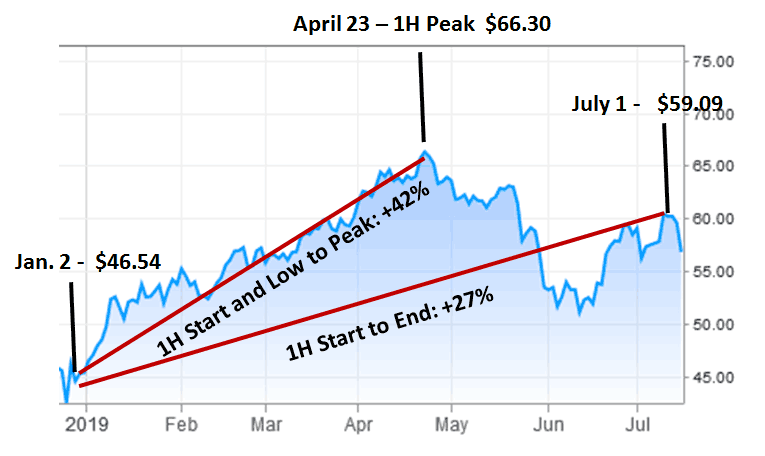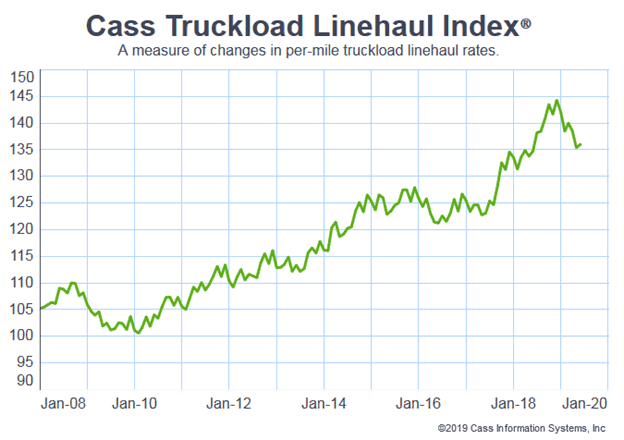Wrapping up our review of the first half year in supply chain 2019, this week we offer our popular look at the six months in numbers and charts.
Last week, I summarized what I thought were the key supply chain themes and trends of 2019 (see 1H Supply Chain Year in Review 2019), which included our top supply chain stories of the first half.
So, let's get right to it.
Gilmore Says.... |
 |
| After a torrid 2018, the Cass truckload Linehaul Index,which tracks truckload rates, slowed consirably here in 2019. |
 |
What do you say? |
|
| Click here to send us your comments |
| |
|
|
|
We always do a check on the US and global economy, as that has such an impact in the end on supply chain practice.
After real GDP growth of 2.9% in 2018 - just missing reaching the 3% growth level amazingly not seen since 2005, Q1 started off the year strong enough at 3.1%, after rising 2.2% in Q4.
But there are concerns the trade wars that dominated supply chain news in 1H 2019, along with growth now for 10 years that may at last be running out of steam, are leading to slower economic growth.
The first official Q2 GDP numbers have not been released, but the Atlanta Federal Reserve Bank now forecasts real GDP growth of just 1.5% in Q2 - up, however, from 1.3% previously.
But growth in China is slowing signficantly, down to 6.2% in Q2, the lowest quarterly level in 27 years - and the official number is almost certainly overstated.
The International Monetary Fund expects the global economy to grow 3.3% in 2019, down from 3.6% in 2018, citing trade concerns.
In the US, the IMF economists foresee 2019 growth of 2.3%. The IMF cut its outlook for the euro-area economy to just 1.3%.
Consistent with a slowing economy, the US Purchasing Managers Index from the Institute of Supply Management managed to stay above the 50 mark that separates manufacturing expansion from contraction every month in the 1H- but barely of late. As seen in the chart below, the PMI was just 51.7, and trending down since the January number of 56.6%.

Another view of US manufacturing strength is the index on output for US factories from the Federal Reserve.
US manufacturing output accelerated in June, climbing for the second straight month, thanks in large part to increased production of motor vehicles and parts.
The Federal Reserve said this week that manufacturing production rose 0.4% last month, above the 0.2% expected by analysts in a Reuters poll.
The June numbers were stronger than the 0.2% growth seen in May, which had been the first growth of 2019 after several months of manufacturing declines or flatness.
However, as can be seen from the chart below, US manufacturing output has been flatish for many years now - and at a June level of 105.2 is just 5.2% above the baseline year of 2012 seven years later, meaning growth of less than 1% annually since then.
What's more, that also means current output remains well below the peak year of 2007, when the index reached an historic high of 110.0 in December.
Oil prices were mostly up in the quarter, though dropping in the last couple of months. The price for WTI started $46.54 per barrel, which turned out to be the lowest level of the 1H.
The price went up steadily until reaching a 1H peak of $66.30 in late April, a gain of 42% from the start. But it was mostly downhill from there, with a price at the end of June of $59.09, a gain of 27% since the beginning of the year.

Despite those rather significant gyrations, US diesel prices were remarkably stable, starting the year at $3.04, rising a bit to a 1H high of just $3.17 the week of May 6, and then falling back to the same $3.04 level that started the year at the end of June.
Commodity and input prices were falling for most of the 1H, after a very long period of increases. The ISM Prices index indicated rising input prices for the 34th straight month in December, but dropped into negative territory in January. The index was below 50 - indicating falling prices - again in February, before popping a bit above 50 for the next three months. The June level dropped again to just just 47.9, clearly signaling demand is weakening and causing falling procurment costs.
Freight volumes were mixed, with ATA freight tonnage index down 6.1% in May (no June number yet). Compared with May 2018, the index increased 0.9%, the smallest year-over-year gain since April 2017. "Tonnage appears to be leveling off," the ATA says - another sign of a slowing economy.
After a torrid 2018, the Cass truckload Linehaul Index,which tracks truckload rates, slowed considerably here in 2019.
As can be seen in the chart below, rates were trending down since the start of the year, and in June were up just 0.9% year-over-year. "The trajectory on a nominal basis strongly suggests that the TL index will go negative next month and stay negative (compared to 2018) through the end of the year," Cass notes, in goods news for shippers.

It was a tough first half for US railroads. Total US rail traffic for 1H 2019 was down 3.1%, while the once fast growing intermodal component was down 3.2%.
In terms of ocean container carriers, the China Containerized Freight Index jumped to a two-year high of 890 at the end of January, coinciding with the tail-end of the great US container import boom, precipitated by the great pull-forward of 2018. But keep in mind that still means rates were more than 10% below those seen in 1998!
The index then promptly fell below 800 late April before ending June at about 815. No wonder carriers can't make any money.
The World Trade Organization expects trade to rise by a mere 2.6% in 2019 - the same as projected global GDP growth (which is lower than the IMF forecast cited above). Not long ago, it was common for global trade to be double the rate of GDP growth.
The US tariiffs are in fact it seems having an impact on Chinese imports, which were down 7.8% in May. But that still left a huge trade gap of $29.9 billion for the month. And recently analysis from AT Kearney found the reduced imports from China are just moving to other Asian countries, with the total import from 14 Asian countries including China up 9% in the first half even as China exports fell.
The growth of ecommerce sales in the US remains strong - but is slowing. Growth in Q1 was 12.4%, according to the Commerce Depart, but that is down from the 15-16% seen until about a year ago. It was 12.1% in Q4.
Amazon is not yet out with its Q2 numbers yet, but in Q1 its total revenue grew 16.9% compared with the year-ago period, representing the slowest expansion since the first quarter of 2015, but taking it to quarterly sales of $59.7 billion. Its North American revenue saw a 17% increase, but much lower than last year's 46% growth.
But it is making money - net income in the quarter was a robust $3.6 billion, a record.
I have lots more but am out of space. Hope you enjoyed all this.
What is your reaction of 1H supply chain 2019 in numbers and charts? What would you add? Let us know your thought at the Feedback section below.
Your Comments/Feedback
|